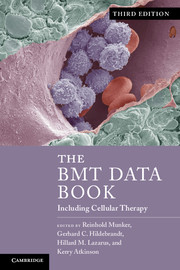Book contents
- Frontmatter
- Contents
- List of contributors
- Foreword
- Preface
- Acknowledgments
- Section 1 Basic science
- Section 2 Hematologic malignancies
- Section 3 Solid tumors
- Section 4 Nonmalignant disorders
- Section 5 Cellular therapy
- Section 6 Practical aspects and procedures
- 21 Practical aspects and procedures, including conditioning protocols and haploidentical transplantation
- 22 Umbilical cord blood as an alternative allogeneic graft source: clinical banking and transplant outcomes
- Section 7 Complications
- Section 8 The BMT/SCT pharmacopoeia
- Section 9 HLA-testing and laboratory medicine
- Appendix Guide to the internet and literature databases relevant for BMT/SCT
- Index
- References
22 - Umbilical cord blood as an alternative allogeneic graft source: clinical banking and transplant outcomes
Published online by Cambridge University Press: 05 August 2013
- Frontmatter
- Contents
- List of contributors
- Foreword
- Preface
- Acknowledgments
- Section 1 Basic science
- Section 2 Hematologic malignancies
- Section 3 Solid tumors
- Section 4 Nonmalignant disorders
- Section 5 Cellular therapy
- Section 6 Practical aspects and procedures
- 21 Practical aspects and procedures, including conditioning protocols and haploidentical transplantation
- 22 Umbilical cord blood as an alternative allogeneic graft source: clinical banking and transplant outcomes
- Section 7 Complications
- Section 8 The BMT/SCT pharmacopoeia
- Section 9 HLA-testing and laboratory medicine
- Appendix Guide to the internet and literature databases relevant for BMT/SCT
- Index
- References
Summary
Introduction and historical background
The clinical applications of UCB comprise growing trends in the fields of transplantation and regenerative medicine. Over 10 000 children and adults worldwide have received UCB transplants, beginning with the first infusion in 1988 (Gluckman et al., 1989). In the ensuing decades, numerous large studies have confirmed the engraftment potential and hematopoietic reconstitution capabilities of UCB grafts, and in addition have revealed multiple unique advantages of UCB as an alternative source of stem cells in patients lacking an available histocompatible sibling allogeneic donor. UCB transplantation has been used effectively to treat hematopoietic malignancies, marrow failures, immunodeficiencies, SCD, β-thalassemia, and inherited metabolic disorders (Eapen et al., 2007; Laughlin et al., 2004; Locatelli et al., 2003; Rubinstein et al., 1998; Staba et al., 2004; Tono et al., 2007). It is estimated that more than 400 000 units of UCB are available worldwide.
The use of UCB addresses several challenges inherent to allo-SCT. Although the availability of HLA-matched adult BM donors through various worldwide registries now approaches 75% for Caucasians, certain ethnic minorities remain difficult to match with available volunteer adult donors (Cicciarelli et al., 2005; Wofford et al., 2007). UCB is readily obtained without risk to mother or infant, and is easily cryopreserved, stored, and transported. Additionally, the use of a patient’s autologous stem cells has been considered for cellular replacement therapies, but is limited due to the fact that stem cell number and function diminish with advancing age (Chambers & Goodell, 2007; Chambers et al., 2007; Rossi et al., 2007), and an invasive procedure is required to procure these cells from the patient. These advantages are increasingly attractive as UCB banking programs become more widespread, improving both the immediate availability of stored units for clinical use and the representation of the population’s genetic background for more robust HLA-matching, impacting transplant outcomes (Ballen et al., 2002; Barker et al., 2002; Krishnamurti et al., 2003).
- Type
- Chapter
- Information
- The BMT Data BookIncluding Cellular Therapy, pp. 288 - 296Publisher: Cambridge University PressPrint publication year: 2013



